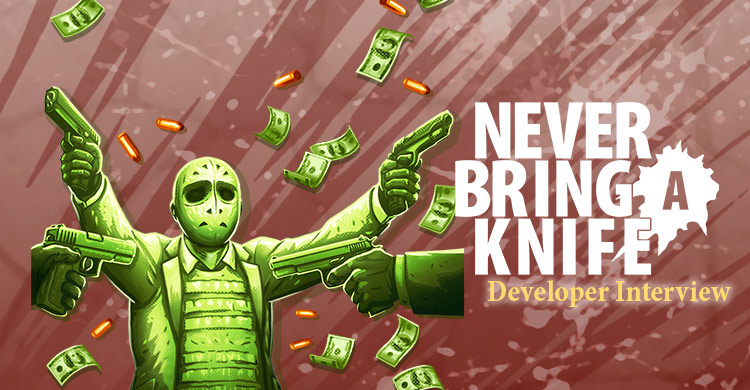Heist Movies and Twists of Fate: An Interview with Never Bring a Knife's Producer

Never Bring a Knife, our newest card game, is a social deduction game with less talking and more shooting. It released on Friday, January 17th. Today, we're sharing our interview with Jeff Tidball, the game's developer and producer.
What caught your eye about Never Bring a Knife?
The thing I liked most the first time I played Never Bring a Knife — called Blindfire, then — was the elegance of a system where every player played exactly four cards, and every player had four cards played on them, and that sometimes, those limits led to unexpected consequences.
I don’t know if it happened in that first game or not, but there’s a certain hilarity in being forced to play a Gun on yourself, or an Armor on an enemy, because of earlier mistakes or due to unexpected developments. As I played more and more, what I increasingly loved is how those moments narratively paralleled the unpredictable action in many of the films I love in the heists-and-gunfights genre — movies like Reservoir Dogs, Heat, and The Town.
Past that, for me, there’s a moment in every game of Werewolf
when the talking gets to be just. too. much. I like talking as much (or more!) than the next person, but I tend to find the fun in games when I just choose a direction and play in it, for better or worse, win or lose. So what I like about Never Bring a Knife is that while there’s room to talk — to bluff, threaten, connive, and convince — players can bring it to an active end by just deciding that they’re ready to play their cards. (Which also seems to me like a very apt reflection of the genre.) I also like that all of the players don’t have to take any heads-down quiet time at the start of play in Never Bring a Knife.
Tell us about the Mole Card.
The last key feature of Never Bring a Knife that we nailed down during development was the Mole card. Unless I’m misremembering, the idea that became that card was suggested by Marcin Zarycki, one of the players in my Wednesday-night playtesting group.
The problem we were trying to solve was the circumstance where, toward the end of a game, one or more players can wind up in a state where victory is essentially impossible but the game’s going to continue for a while anyway. Those situations are pretty much the definition of “not fun.”
Although the Mole card is rare — there’s only one in the deck — the introduction of team-switching possibilities maintains the chance that something will change in a seemingly resolved game, which is often all one needs for the game to continue to be engaging. Nearly all of Western dramatic storytelling teaches us to root for the outside chance.
What’s really nice with the Mole card, though, is that a team-swap can resolve in multiple ways: A losing player could switch to the winning team, a player who’s causing the losing team to lose could be thrown to the other team and reverse almost everyone’s fortunes, or the whole win/lose dynamic could be flipped entirely upside-down if the boss’s tiebreaker role comes into play. And since these situations can come up when any player draws the Mole card, the chances of some kind of unexpected reversal are higher than they would be if only one player could draw and play a Mole card successfully to change their own end-of-game fortunes.
The other nice thing about the Mole card is that, mid-game, it can re-introduce uncertainty in the team breakdown for a player who thinks they’ve figured everything out. That’s a nice side effect of having that card in the deck.
What’s something you put a lot of thought into that might not be obvious at first glance?
At Atlas Games, our releases are generally hobby games for folks aged 14 and older. In light of the American landscape, my playtesting experiences, and my experience as a father, I pitched to Atlas Games’s owners the idea that Never Bring a Knife should be recommended as a game for 17-year-olds and up — the same age range as the R-rated movies that provide a lot of the inspiration for the game.
The content of the game and its impact on players were a constant consideration during development of Never Bring a Knife. Shootings are not new in America, but as we were moving toward the final stages of publishing Never Bring a Knife, there was a series of higher-profile shooting in the news.
Also around that time, I had a playtest experience where one player finished the game and said that he never wanted to play it again, because he never again wanted to have an experience where he, as a white person, had to take on the role of a police officer shooting a player who was a person of color. I thought a lot about that playtester’s feedback. And, I should say, I am grateful for it.
At the end of the day, while I don’t think that violent entertainment is morally wrong, I also don’t care to suggest that it isn’t worth thinking about. I also believe that the ideas we allow into our head affect us, including the art and entertainment we watch and participate in. That’s why Never Bring a Knife is rated for, and intended for, mature players. I think it’s appropriate, and I’m glad Atlas Games’ owners agreed to label the game as such.
Never Bring a Knife plays 4-8 people, ages 17+, in 20-25 minutes. Learn more or read an interview with the game's co-designer Maggie Clyne.
